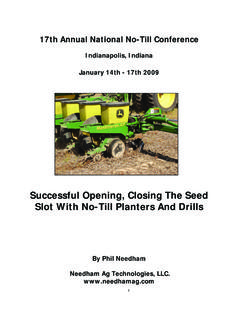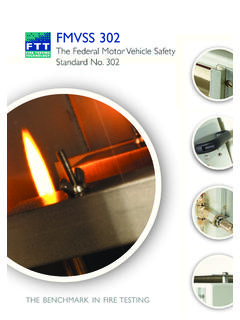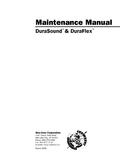Transcription of WOODWORKS: INTERMEDIATE PROJECT SIDE TABLE
1 1 woodworks : INTERMEDIATE PROJECT side TABLEHere s a perfect TABLE for use in a front hall, behind a living-room sofa or in your bedroom for showcasing your favorite knickknacks. Besides beingnarrow enough to fit in a variety of locations, its two drawers provide convenient storage for small items. For INTERMEDIATE woodworkers, the taperedlegs, doweled joints and close tolerances throughout will present a challenge but also produce great satisfaction when properly executed. And whenit s all assembled, you ll learn more about applying and using stains and finishes to protect the wood and keep it looking - woodworks : INTERMEDIATE PROJECT 2006-2007 side TABLE 2 TOOLS REQUIREDSHOPPING LISTWOOD FINISHING PRODUCTSHand Tools Hammer Nail set 4' pipe clamp 18" pipe clamps (4) Doweling jigPower Tools Tablesaw with combinationrip/crosscut blade and dado blade Saber saw Router, 3/8" roundover bit Jigsaw Electric drillMiscellaneous Pencil Tape measure Safety glasses Carpenter s glue 120, 150 and 220-grit sandpaper Clean, lint-free cloths Respirator Gloves for finishing Mineral spirits (for oil-based stainsand finishes) Water-filled metal container withtight-fitting lid (for oil-based stainsand finishes waste products) Minwax Wood Finish StainBrush or other good quality,natural-bristle brush (for oil-based stains and finishes) Minwax Polycrylic Brush or othergood quality, synthetic-bristle brush(for water-based stains and finishes)Recommended Finish Prep: Minwax Pre-Stain Wood ConditionerStain.
2 Minwax Wood Finish English Chestnut (or your choiceof any of the 22 Minwax Wood Finish Stain colors)Finish: Minwax Wipe-On Poly Satin or Gloss Alternate Finish Prep: Minwax Water-Based Pre-Stain Wood ConditionerStain: Minwax Water-Based Wood Stain Verdigris (or a Minwax Water-Based Stain of your choice, available in 6 wood tones,60 custom colors and 8 bold Accents colors)Finish: Minwax Polycrylic Protective Finish Semi-GlossItemQuantity1x8 oak1 @ 9', 2 @ 6'2x4 birch1 @ 6'1x6 birch2 @ 6'1x4 birch2 @ 6'1/4" birch plywood1 @ 12" x 36"4d finish nails503/8" x 2" dowel pins16#8 x 3/4" pan-head screws with washers 2 Oak drawer knobs2 Tabletop fasteners6 Overall Dimensions: 32"H x 48"W x 14"DKeyPartPcs. MaterialDimensionsATable top1oak3/4" x 14" x 48"BLegs4birch1-1/2" x 1-1/2" x 31-1/4"CFront & back aprons2birch3/4" x 4-1/2" x 37"DSide aprons2birch3/4" x 4-1/2" x 10"EDrawer fronts2birch3/4" x 3-5/8" x 15-1/2"FDrawer sides4birch3/4" x 2-7/8" x 11"GDrawer backs2birch3/4" x 2-3/8" x 13-3/4"HUpper drawer runners2birch3/4" x 2" x 10-3/4"JDrawer runners4birch3/4" x 1-1/2" x 10-3/4"KDrawer runners4birch3/4" x 3/4" x 10-3/4"LStop blocks2birch3/4" x 3/4" x 6"MDrawer bottoms2birch plywood 1/4" x 10-3/4" x 13-3/4"NDrawer stops2birch plywood 1/4" x 1" x 3"Recommended Wood: Oak/BirchAlternate Wood: Pine (stain grade)CUTTING LISTBEFORE YOU BEGINGood craftsmanship begins and ends with good work habits, so makethe following steps part of your routine workshop practice.
3 If you haveany doubts or questions about how to proceed with a PROJECT , alwaysdiscuss them with your shop instructor. Carefully and fully review plans and instructions before putting atool to the PROJECT lumber. Work sensibly and safely. Wear safety goggles when doing work thatcreates flying chips and sawdust; wear the appropriate respiratorwhenever making sawdust or working with thinners or other solvents. At the end of every work session, clean up your shop area and putaway all portable AND ASSEMBLY PROCEDUREGlue the make the top (A), edge-glue together two 1 x 8 boards that are49" long. Alternate the direction of the growth rings in the end grain ofthe boards to prevent the top from warping. After the glue has dried,cut the top to its finished the Initial all the pieces, (B) through (N), to the dimensions given in theCUTTING the drawer runner pieces, (J) and (K), the LegsThe legs are made of solid birch stock 1-1/2" thick. If you have troublefinding birch that thick, glue together two 3/4" pieces.
4 The taper ontwo sides of each leg is easy to cut with a homemade tapering drawers are boxes assembled with nails very easy to make andalign and they ride on wooden the leg-tapering jig by cutting a 3/4"-thick piece of scrapplywood 5" wide by 33" long (Fig. 4). Draw the angled side as shownin the diagram and cut out the notch with a saber cut the legs, set the tablesaw fence 5" from the saw blade andset the blade slightly higher than 1-1/2". You must cut a taper on twoadjacent sides of each leg and leave the sides that fit against theaprons uncut. Place a leg (B) in the notch of the taper jig and slidethe jig across the TABLE , holding it tight to the fence (Fig. 5). Use apush stick to hold the leg tight against the side of the notch as you cutthe taper. Rotate the leg 90 degrees in the jig so the tapered side youjust cut is facing up, then cut the other tapered side of the leg. Repeatthese steps for the remaining three the Dowel the dowel holes can be confusing unless you first markwhich sides of the legs (B) and ends of the apron pieces (C) gotogether.
5 The easiest way to do this is to place all the legs and apronpieces upside down on your worktable in the relative positions they llassume when the base is assembled. Label each joint with a differentidentifying mark so you can assemble it the same way ss TTiipp::Drilling the dowel holes in the legs and apronsis simpler and more accurate if you use a dowel-drilling jig. Place apiece of masking tape on the drill bit for a depth stop the positions of the dowel holes in the sides of the legs andthe ends of the apron pieces (Fig. 3). Offset the dowels slightly on each side of the legs so they won t interfere with each other. Drill the 3/8"-diameter dowel holes. the tablesaw blade set 1/4" high, cut the grooves for thetabletop fasteners 1/2" from the top edge of the front and backaprons (C, Figs. 3 and 6).Assembling the TableThere are three stages in assembling the TABLE . First, construct theframe from the legs and apron pieces. Second, make the , complete the top, which has already been glued together and cut to the out and cut the two drawer openings in one of the long apronpieces (C).
6 To do this, drill 3/8" holes within the cutout area ofeach opening. Then use a saber saw to cut along each line. Proceedslowly and carefully to ensure straight cuts and square the cutting, file and sand all edges smooth. the legs and aprons with 120-grit paper, then smooth them allwith 180-grit paper. Dowel, glue and clamp the front legs to the frontapron and the back legs to the back apron. Then dowel, glue andclamp the side aprons to the assembled front and back. Quickly wipeaway excess glue with a damp the the holes for the knobs in the drawer fronts (E, Fig. 1).Shape the drawer front edges with a router and 3/8" roundover rabbets 1-1/8" wide by 3/8" deep on the inside ends of thedrawer fronts, using a dado blade on the tablesaw. Use the tablesawmiter gauge to ensure square cuts. Clamp a stop block to the fence to hold the piece the correct distance from the blade. Cut rabbets3/4" wide x 1/4" deep on the back ends of the drawer sides (F) inthe same way (Fig.)
7 2). Cut the grooves for the drawer bottoms (M) in the drawer fronts and all the drawer pieces, then glue and clamp all the piecestogether except for the drawer bottoms. Push the bottoms into theirgrooves after finishing, to avoid having to wipe the stain and topcoatout of the pilot holes, and then drive finish nails through the drawersides into the drawer fronts and backs. To make nailing easier, clampthe drawer front or back in a vise so that the drawer side is supportedon the top edge of the vise jaw. Use a nail set to finish driving the nailsinto the drawer fronts past the lips of the the upper drawer runners (H, Fig. 1) between the frontand back aprons. Use a clamp to hold them in place, then drillpilot holes and drive finish nails. Use a nail set to drive the headsbelow the surface. Fill the nail holes with wood putty. Then glue thestop block (L) in place at the bottom of each drawer opening inthe front apron. 3 CONTINUED - woodworks : INTERMEDIATE PROJECT 2006-2007 side TABLEA ffix the Lower mount the runners (J, K) that guide the sides and bottoms ofthe drawers, set the TABLE base on its back and align the drawers intheir openings.
8 Set them tight to the bottom edge of the opening in theapron, with an even gap on each the drawer runners in place and mark their outside edgeson the front and back aprons (Fig. 6). Mark where the ends of thedrawer runners join the front and back apron pieces. Leave a 1/32"gap between the runners and the sides of the drawers. Hammer finishnails through the aprons and into the drawer runners to hold themin place. Use a nail set to drive the nailheads slightly below the the nail holes with wood the drawer assembly after the final topcoat is dry. Slide thedrawer bottoms (M) into their grooves and then fasten them with two4d finish nails driven into the drawer the knobs to the drawer fronts and pivoted stops to thebacks of the drawers. The stops are 1"x 3" pieces of 1/4" them with a single pan-head screw and a washer (see DrawerSection View, Fig. 2). the top to the base with TABLE fastener brackets (Fig 6).Leave a 1/16" space between the fasteners and the aprons to allow thetop to expand.
9 Turn the rear drawer stops horizontal so you can slidethe drawers in place. Then turn the stops downward so the drawerswon t fall out when you open AND FINISHINGWW ooooddwwoorrkkeerr ss TTiipp::Though you may be tempted to cut shortyour sanding, preparation and application time, don t do tasks are very important steps in obtaining a high-qualityfinish. Remember, it is the finish, just as much as the fit andsmoothness of the parts that will have great bearing on howpeople judge your craftsmanship. To ensure an excellent result,follow the steps listed in this section and also the instructionsthe finish manufacturer puts on its TIPS Test the stains and finishes you are planning to use on scraps ofwood. On the back of the scrap, mark the stain/finish combinationand the type of wood. Allow all samples to dry thoroughly beforemaking your final finish selection. Save your samples for quickreference on future projects. All stains and finishes must be allowed to dry thoroughly betweencoats.
10 Remember that drying times can vary due to humidity andother climatic conditions. If you have some leftover stain or finish, wipe the can rim so thatstain or finish in the rim won t dry out and prevent the lid fromforming a tight seal. Brushes used for water-based products, such as Minwax Water-Based Wood Stains or Minwax Polycrylic Protective Finish, mustbe cleaned with soap and water; oil-based finishes must be cleanedwith mineral all pieces starting with 120-grit paper, then move up to 220-grit to complete the pre-finish smoothing. Use an orbital sander toremove any marks or scratches, then lightly sand by hand using with-the-grain sanding strokes. Dust off the piece and wipe it carefully witha clean, lint-free cloth lightly dampened with mineral the Minwax Wood Finish you ve chosen to the interiorsurfaces using a natural-bristle brush and a clean, lint-free clothfollowing the directions on the can. The brush will help you get thestain into the many inside corners and other tight spots.









